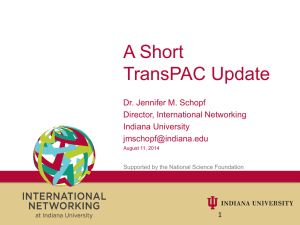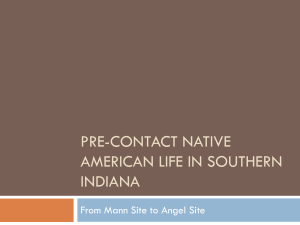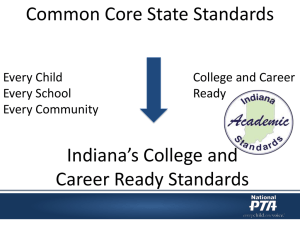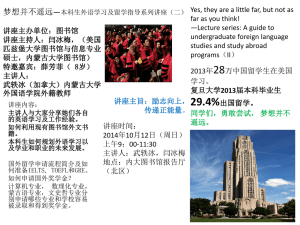America Connects to Europe - International Networks at IU
advertisement
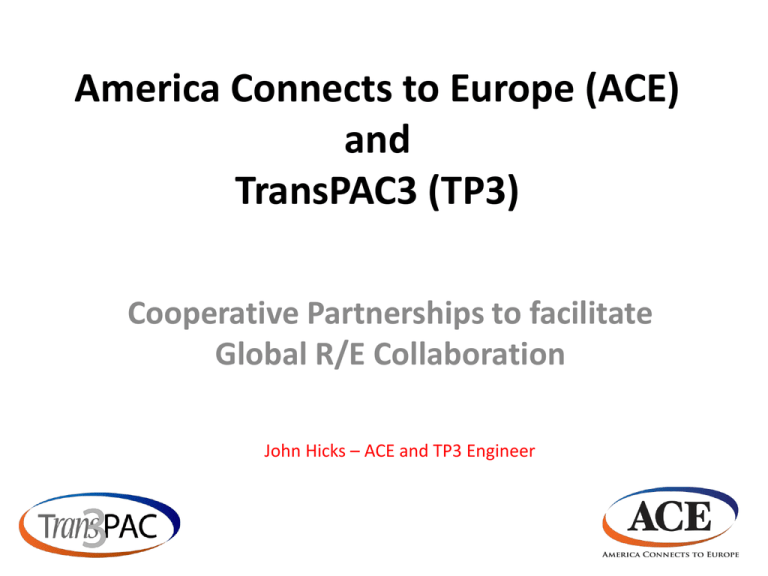
America Connects to Europe (ACE) and TransPAC3 (TP3) Cooperative Partnerships to facilitate Global R/E Collaboration John Hicks – ACE and TP3 Engineer Topics • The US National Science Foundation and the International Research Network Connections Program [NSF IRNC] • Indiana University, the GlobalNOC and International Networking at Indiana University [IN@IU] • ACE and TP3 • DYNES • DyGIR • IRIS John Hicks- Indiana University jhicks@iu.edu The US National Science Foundation and the International Research Network Connections Program [NSF IRNC] NSF – US government agency. Budget: $8 billion focused on advancing “science” in the broadest sense. See: http://www.nsf.gov/ IRNC – Program within the NSF Office of Cyberinfrastructure (OCI). Budget: $40 million over 5 years [2010-2015]; focus on providing production quality network infrastructure to increase/advance international science collaborations. See: http://irnclinks.net/ Note: The NSF does NOT fund US domestic R/E infrastructure. That is funded by the universities (Internet2 or NLR networks) or US government labs (ESnet as an example). OCI also funds a variety of high-performance computing activities, security research and a number of network research programs. See: http://www.nsf.gov/dir/index.jsp?org=OCI The ACE and TP3 awards are funded by the NSF through OCI and administered by Indiana University. John Hicks- Indiana University jhicks@iu.edu Indiana University, the GlobalNOC and International Networking Indiana University: 8 campus state university system; core campuses in Bloomington and Indianapolis. See: http://indiana.edu/ . A strong research focus: http://research.indiana.edu/ GlobalNOC: The outward facing “networking” part of Indiana University. 80+ Staff; provides engineering and operations support to multiple networks including Internet2, NLR, NOAA-NWave, various US regional networks and ACE+TP3 International Networking [IN@IU]: International face of GlobalNOC; engineering and operational support for ACE and TP3; science and services outreach John Hicks- Indiana University jhicks@iu.edu ACE and TP3 5 year [2010-2015] NSF IRNC funded projects; $1M/year each; focus on production networking in support of R/E, but with support for network research also. TP3: US-Asia connectivity (Tokyo-LA 10G); extended into South Asia and to Europe by TEIN3; partnering with APAN and JGN-X ACE: Multiple 10G connections US->EU; balanced by similar EU->US connections; cooperative engineering and operations; cooperative technical planning via DICE. ACE+TP3 combined with GEANT, TEIN3, APAN and Internet2 create a globespanning network ring. John Hicks- Indiana University jhicks@iu.edu <Good network picture goes here> John Hicks- Indiana University jhicks@iu.edu <Good network picture goes here> James Williams - Indiana University williams@indiana.edu John Hicks- Indiana University jhicks@iu.edu ACE and TransPAC3 Details ACE will supply multiple 10G connections between the US-EU balanced by EUUS connections, increasing capacity as demand warrants. Step 1, in cooperation with GEANT, planned 2x10G aggregated links to NYC and DC, a link from NYC to London. We expect these connections to be in place on/about September-2011. TransPAC3 will supply multiple 10G connections between the US and Asia. The initial connection is in place now. We are researching we a second connection might be located. Not just infrastructure….services over infrastructure and science support. Security and measurement services are critical and, the reason for the IRNC program is to support science. John Hicks- Indiana University jhicks@iu.edu Services over infrastructure Measurement: development and dissemination of both capacity planning and enduser (end-to-end) tools. See: http://www.perfsonar.net/ and http://irnclinks.net/ particularly the IRIS and 6Watch activities Dynamic circuit capability: ability of researchers to provision end-to-end bandwidth without engineering intervention <very difficult technically and politically> See: https://intranet.geant.net/sites/Networking/NA4/T1/Pages/DICEDynamics.aspx/ and http://irnclinks.net/ particularly the DyGIR activity DYNES - A US project to provide extended dynamic circuit development combined with actual CI instrument creation. See: http://www.internet2.edu/ion/dynes.html Security: the most difficult problem; Security Event Sharing (SES) proposed as a part of ACE+TP3. See: http://www.ren-isac.net/ses/ Network research: provide a platform for research without endangering production services; OpenFlow interest. See: http://www.openflow.org/ John Hicks- Indiana University jhicks@iu.edu DYNES (Development of Dynamic Network System) Deployment Plan and Schedule The DYNES deployment plan and schedule proposed to the NSF identified four project phases. • Phase 1: Site Selection and Planning (4 months) (Sep-Dec 2010) • Phase 2: Initial Development and Deployment (6 months) (Jan 1-Jun 30, 2011) • development of DYNES at a limited number of sites • sites will be a minimum of Caltech, University of Michigan and Vanderbilt and their regional networks, plus 2-3 additional campuses (such as the University of Nebraska) and at least one of their respective regional networks. • Phase 3: Scale Up to Full-scale System Development (14 months) (July 1, 2011-August 31, 2012) • full-scale deployment and development at all selected sites • Phase 4: Full-Scale Integration At-Scale; Transition to Routine O&M (12 months) (September 1, 2012-August 31, 2013) • DYNES will be operated, tested, integrated and optimized at scale, transitioning to routine operations and maintenance as soon as this phase is completed John Hicks- Indiana University jhicks@iu.edu DyGIR (Dynamic Gateway for International Research) - NSF Award Abstract — #0962705 •The DyGIR project will provide a solution for scheduling dynamic circuits on IRNC infrastructure. •DyGIR will help to providehybrid network services including dynamic circuit services •interoperable with emerging production dynamic switching network services in the US (e.g. ESnet, Internet2) and in other countries (e.g. GÉANT3, JGN2). •DyGIR will advance the state of the art of dynamic circuit networking in support of international science and engineering by developing new functionality, particularly for international exchange points. •DyGIR will increase the opportunity for scientific collaboration between distributed research efforts by enabling the predictable network performance required to effectively share large data sets. John Hicks- Indiana University jhicks@iu.edu IRIS (International Research Instrumentation System) - NSF Award Abstract — #0962704 •IRIS will provide a software framework to simplify the task of end-to-end network performance monitoring and diagnostics •IRIS will deliver a comprehensive monitoring package that will deliver instant access to status and health of networks. •IRIS facilitates a broader deployment of perfSONAR •IRIS will have a significant impact on the broad international science and engineering network user community by providing key measurement tools with global applicability. •IRIS will advance the state of network measurement and monitoring by working with IRNC projects to research and implement solutions to challenging network measurement problems. This to have a broad impact among multiple scientific disciplines involving global collaboration and exchange of large data sets. John Hicks- Indiana University jhicks@iu.edu Science Support Primary focus of ACE+TP3 is supporting/increasing US international R/E collaborations Workshops are a mechanism for increasing collaborations, particularly in “developing/emerging” regions. Completed a workshop in India: See: http://internationalnetworking.indiana.edu/us-india-workshop We are interested in Africa and Southeast Asia as possible locations for future workshops. Some interesting US international science projects are located at: http://www.nsf.gov/od/oise/pire2010-list.jsp John Hicks- Indiana University jhicks@iu.edu On behalf of the US research and education networking community, the NSF, and Indiana University, we look forward to close collaboration with Europe and Asia as we work together to develop world class IT infrastructure to enable and facilitate world class science. There are large technical and financial challenges in front of us. But, cooperatively, we can build the infrastructure and services needed to support the next generation of global research and education. Questions? Feel free to contact me: jhicks@iu.edu Visit our web site: http://internationalnetworking.indiana.edu/ John Hicks- Indiana University jhicks@iu.edu Indiana University gratefully acknowledges the support of the National Science Foundation via awards: SCI – 0962973 - America Connects to Europe (ACE) and SCI - 0962968 America Connects to Asia (TP3) John Hicks- Indiana University jhicks@iu.edu References and additional information IN@IU: http://internationalnetworking.indiana.edu/ ACE: http://internationalnetworking.indiana.edu/ACE TP3: http://internationalnetworking.indiana.edu/TP3 IRNC projects: http://irnclinks.net/ Internet2: http://internet2.edu/ DyGIR: http://irnclinks.net/ IRIS: http://irnclinks.net/ DYNES: http://www.internet2.edu/ion/dynes.html DICE: http://www.geant.net/Network/GlobalConnectivity/Pages/InternationalCollaboration.aspx ESnet: http://www.es.net/ ESnet: http://fasterdata.es.net/ ESnet: http://www.internet2.edu/presentations/jt2011winter/20110201-dart-science-dmz.pdf PIRE: http://www.nsf.gov/od/oise/pire-2010-list.jsp John Hicks- Indiana University jhicks@iu.edu

